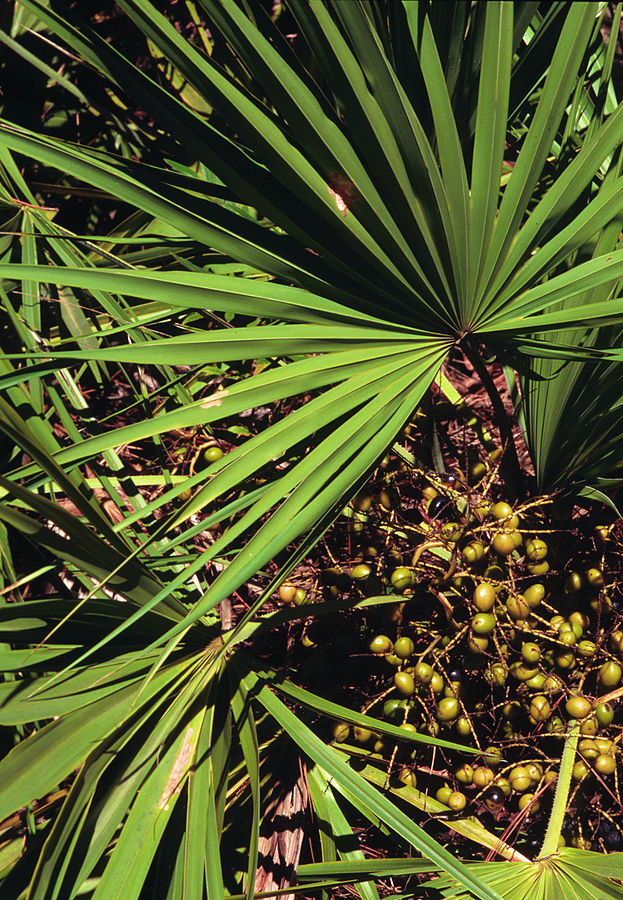Common Names: saw palmetto, American dwarf palm tree, cabbage palm
Background
- Saw palmetto is a small palm tree native to the southeastern United States. Its fruit was used medicinally by the Seminole Tribe of Florida.
- Currently, saw palmetto is used as a dietary supplement for urinary symptoms associated with an enlarged prostate gland (also called benign prostatic hyperplasia or BPH), as well as for chronic pelvic pain, decreased sex drive, migraine, hair loss, and other conditions.
- Extracts of the fruit of saw palmetto are used in tablets or capsules. Saw palmetto has also been used as ground, dried, or whole berries, a liquid extract, or a tea.
How Much Do We Know?
- Rigorous, well-conducted studies have evaluated saw palmetto for urinary tract symptoms associated with prostate enlargement in men.
- Much less is known about the use of saw palmetto as a dietary supplement for other health purposes or by other groups of people.
What Have We Learned?
- The scientific evidence does not support using saw palmetto for any health condition.
- High-quality scientific studies have shown that saw palmetto is no more effective than a placebo (an inactive substance) in relieving urinary tract symptoms caused by prostate enlargement. These studies include a 2011 NIH-funded study that tested saw palmetto in amounts up to three times the usual dose.
What Do We Know About Safety?
- Saw palmetto is well tolerated by most users. It may cause mild side effects, including digestive symptoms or headache.
- Saw palmetto does not appear to affect readings of prostate-specific antigen (PSA) levels, even when taken in higher-than-usual amounts. PSA is a protein produced by the prostate gland. PSA levels have been used to screen for prostate cancer and are also used to monitor patients who have been diagnosed with prostate cancer.
- Saw palmetto has not been shown to interact with medications.
- Information on the safety of saw palmetto comes primarily from studies in men. Little is known about the safety or side effects of saw palmetto in women or children.
Keep in Mind
- Urinary tract symptoms can have several causes, including conditions such as prostate cancer that need prompt treatment. If you’re having problems with urination, it’s important to tell your health care provider.
- Tell all your health care providers about any complementary or integrative health approaches you use. Give them a full picture of what you do to manage your health. This will help ensure coordinated and safe care.
For More Information
NCCIH Clearinghouse
The NCCIH Clearinghouse provides information on NCCIH and complementary and integrative health approaches, including publications and searches of Federal databases of scientific and medical literature. The Clearinghouse does not provide medical advice, treatment recommendations, or referrals to practitioners.
PubMed®
A service of the National Library of Medicine, PubMed® contains publication information and (in most cases) brief summaries of articles from scientific and medical journals. For guidance from NCCIH on using PubMed, see How To Find Information About Complementary Health Approaches on PubMed.
Office of Dietary Supplements (ODS), National Institutes of Health (NIH)
ODS seeks to strengthen knowledge and understanding of dietary supplements by evaluating scientific information, supporting research, sharing research results, and educating the public. Its resources include publications (such as Dietary Supplements: What You Need to Know), fact sheets on a variety of specific supplement ingredients and products (such as vitamin D and multivitamin/mineral supplements), and the PubMed Dietary Supplement Subset
Key References
- Agbabiaka TB, Pittler MH, Wider B, et al. Serenoa repens (saw palmetto): a systematic review of adverse events. Drug Safety. 2009;32(8):637-647.
- Andriole GL, McCollum-Hill C, Sandhu GS, et al. The effect of increasing doses of saw palmetto fruit extract on serum prostate specific antigen: analysis of the CAMUS randomized trial. Journal of Urology. 2013;189(2):486-492.
- Avins AL, Lee JY, Meyers CM, et al. Safety and toxicity of saw palmetto in the CAMUS trial. Journal of Urology. 2013;189(4):1415-1420.
- Barry MJ, Meleth S, Lee JY, et al. Effect of increasing doses of saw palmetto extract on lower urinary tract symptoms: a randomized trial. JAMA. 2011;306(12):1344-1351.
- Croom EM, Chan M. Saw palmetto. In: Coates PM, Betz JM, Blackman MR, et al., eds. Encyclopedia of Dietary Supplements. 2nd ed. New York, NY: Informa Healthcare; 2010:700-710.
- Saw palmetto. Natural Medicines Web site. Accessed at naturalmedicines.therapeuticresearch.com/ on April 23, 2015. [Database subscription].
- Saw palmetto berry. In: Blumenthal M, Goldberg A, Brinckmann J, eds. Herbal Medicine: Expanded Commission E Monographs. Newton, MA: Integrative Medicine Communications; 2000:335-340.
- Tacklind J, MacDonald R, Rutks I, et al. Serenoa repens for benign prostatic hyperplasia. Cochrane Database of Systematic Reviews. 2012;(12):CD001423. Accessed at http://www.thecochranelibrary.com(link is external) on April 23, 2015.
This publication is not copyrighted and is in the public domain. Duplication is encouraged.
Let’s Keep in Touch
Sign Up for The Creative Cottage Newsletter










+ There are no comments
Add yours